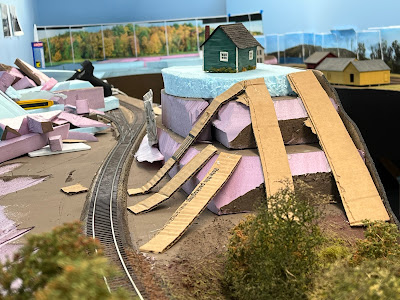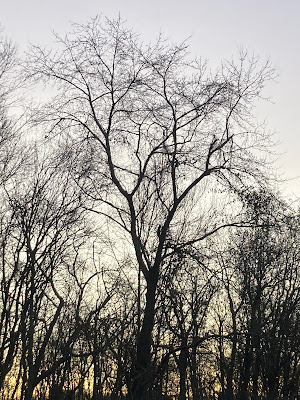I think that I shall never see
A poem lovely as a tree.
A tree whose hungry mouth is prest
Against the earth’s sweet flowing breast;
A tree that looks at God all day,
And lifts her leafy arms to pray;
A tree that may in Summer wear
A nest of robins in her hair;
Upon whose bosom snow has lain;
Who intimately lives with rain.
Poems are made by fools like me,
But only God can make a tree.
You've likely heard - and perhaps even participated - in the debate of whether model railroading is art. But have you ever thought of it as worship or contemplation?
After being sick all this past week, and almost missing Thanksgiving entirely, I woke up this morning feeling much better and noticed the beautiful sunrise from my back deck. The mood was enhanced by some nice seasonal music playing in the background (do yourself a favor and check out this song in particular). I couldn't help but try and capture it in the photograph above and the scene reminded me of the poem by Joyce Kilmer - " . . . only God can make a tree."
I think any time we engage in any creative endeavor, whether it be music, painting, dance, sculpture, or any of the arts - any time we create something for the purity of it
itself - we are affirming our innate humanness and participating with God in Creation. While we can never be God, I believe our creative endeavors are reflections of the
Imago Dei in our lives.
In this respect, our attempts at creating miniature worlds are echoes of our true identity as humans. We are born creators and while our attempts can never be any more than a mere reflections of the real world, I believe that the process of creating that world can itself be a contemplative exercise, affirming our humanity and providing an oasis in the midst of troubling times.
Is it any wonder, then, that a creative hobby can be so calming and restorative? And I think doing it can sometimes be an act of thanksgiving, thanking our Creator for the privilege of being able to participate in creation, in even a small way.
I've spent the past couple of Sunday afternoons dipping my toe in the deep end of this pool, trying my best to make some trees . . .
 |
| I started with armatures from Scenic Express, separating them into separate "trees" and spray painting them a medium gray color. When I was young, I always colored trees brown - but, turns out, they're often mostly shades of gray. |
 |
| While the instructions recommend soaking the armatures in matte medium, I'm following the path many others have taken and am using hairspray (the cheapest, firmest hold you can get) to affix the "leaves" (various colors of flocking) to the armatures. I heavily spray the armature, then sprinkle the flocking over an old pie pan, which I then use to pour the excess flocking back into the container it came from. |
 |
| It's a slow process - it took me an entire afternoon to do the trees you see above - but hopefully I'll get faster with practice. |
 |
| But the results are definitely worth the time. |
That's another thing I'm learning as I do more scenery on the layout: the time it takes often results in a better product, and the process itself can put you in a better, calmer, more contemplative frame of mind.
This Thanksgiving season, I hope you'll have a little extra time to spend working on your layouts - or doing whatever hobby you're in the mood for. And if you do, I hope you'll reflect on how blessed we are that, no matter what our level of skill or ability, we're able to create something that can bring us joy and maybe even a little peace.
From our home to yours, we wish you, your families and friends, a blessed Thanksgiving and holiday season.
(While this post was first published Thanksgiving, 2022 I think it fitting to repost in keeping with the spirit of the season, and to remind me to keep things in their proper perspective, being truly grateful for all my many blessings despite all that's going on in the world around us. I hope it helps you too during these difficult times.)













































